

The Hallmarks of Cancer. To view the full text, please login as a subscribed user or purchase a subscription.
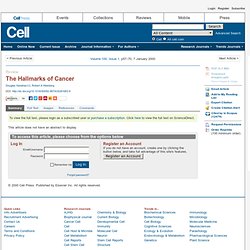
Click here to view the full text on ScienceDirect. Figure 1 Acquired Capabilities of Cancer We suggest that most if not all cancers have acquired the same set of functional capabilities during their development, albeit through various mechanistic strategies. Figure 2 The Emergent Integrated Circuit of the Cell Progress in dissecting signaling pathways has begun to lay out a circuitry that will likely mimic electronic integrated circuits in complexity and finesse, where transistors are replaced by proteins (e.g., kinases and phosphatases) and the electrons by phosphates and lipids, among others.
Figure 3 Tumors as Complex Tissues The field of cancer research has largely been guided by a reductionist focus on cancer cells and the genes within them (left panel)—a focus that has produced an extraordinary body of knowledge. Figure 4 Parallel Pathways of Tumorigenesis This article does not have an abstract to display. p53. Fas receptor. The FAS receptor (FasR), also known as apoptosis antigen 1 (APO-1 or APT), cluster of differentiation 95 (CD95) or tumor necrosis factor receptor superfamily member 6 (TNFRSF6) is a protein that in humans is encoded by the TNFRSF6 gene.[1][2] The Fas receptor is a death receptor on the surface of cells that leads to programmed cell death (apoptosis).
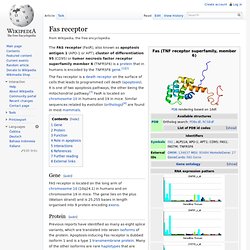
It is one of two apoptosis pathways, the other being the mitochondrial pathway.[3] FasR is located on chromosome 10 in humans and 19 in mice. Similar sequences related by evolution (orthologs)[4] are found in most mammals. Gene[edit] FAS receptor is located on the long arm of chromosome 10 (10q24.1) in humans and on chromosome 19 in mice. Protein[edit] Previous reports have identified as many as eight splice variants, which are translated into seven isoforms of the protein. Function[edit] Fas forms the death-inducing signaling complex (DISC) upon ligand binding. Metastasis. Some cancer cells acquire the ability to penetrate the walls of lymphatic and/or blood vessels, after which they are able to circulate through the bloodstream (circulating tumor cells) to other sites and tissues in the body.
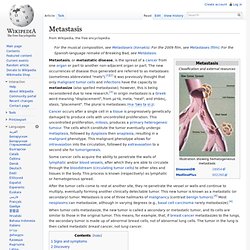
This process is known (respectively) as lymphatic or hematogenous spread. After the tumor cells come to rest at another site, they re-penetrate the vessel or walls and continue to multiply, eventually forming another clinically detectable tumor. Alterations in Cell-Extracellular Matrix Interactions during Progression of Cancers. Angiogenesis. Angiogenesis is the physiological process through which new blood vessels form from pre-existing vessels.
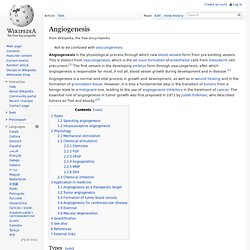
On the mechanics of a growing tumor. Abstract In this paper we study tumor growth within the framework of Continuum Mechanics, considering a tumor as a specific case of a growing soft tissue.

Using the notion of multiple natural configurations we introduce a mechanical description that splits volumetric growth and mechanical response into two separate contributions. Growth is described as an increase of the mass of the particles of the body and not as an increase of their number. Anchorage dependence of growth. Assoian, R.

K. & Zhu, X. (1997) Cell anchorage and the cytoskeleton as partners in growth factor dependent cell cycle progression. Curr.Opin.Cell Biol. 9, 93-98. Boeda, B., El-Amraoui, A., Bahloul, A., Goodyear, R., Daviet, L., Blanchard, S., Perfettini, I., Fath, K. R., Shorte, S., Reiners, J., Houdusse, A., Legrain, P., Wolfrum, U., Richardson, G. & Petit, C. (2002) Myosin VIIa, harmonin and cadherin 23, three Usher I gene products that cooperate to shape the sensory hair cell bundle.
EMBO J. 21, 6689-6699. Stresses in growing soft tissues. Abstract Biochemical processes of tissue growth lead to production of new proteins, cells, and other material particles at the microscopic level.
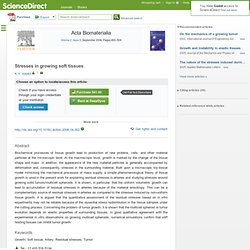
At the macroscopic level, growth is marked by the change of the tissue shape and mass. Cancer genetics. Abstract The accumulation of multiple genetic changes underlies the process of tumorigenesis, and both dominantly acting oncogenes and inactivated tumor suppressor genes co-exist in the same tumor.
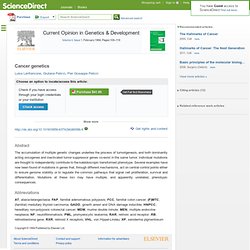
Individual mutations are thought to independently contribute to the kaleidoscopic transformed phenotype. Several examples have now been found of mutations in genes that, through different mechanisms, act on central control points either to ensure genome stability or to regulate the common pathways that signal cell proliferation, survival and differentiation. Mutations at these loci may have multiple, and apparently unrelated, phenotypic consequences. Abbreviations. The mechanism of action of transforming growth factor-β. Wnt signaling pathway. Wnt signaling was first identified for its role in carcinogenesis, but has since been recognized for its function in embryonic development.
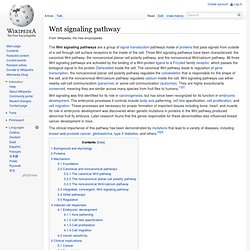
The embryonic processes it controls include body axis patterning, cell fate specification, cell proliferation, and cell migration. These processes are necessary for proper formation of important tissues including bone, heart, and muscle. Its role in embryonic development was discovered when genetic mutations in proteins in the Wnt pathway produced abnormal fruit fly embryos. Later research found that the genes responsible for these abnormalities also influenced breast cancer development in mice. TrkA receptor. High affinity nerve growth factor receptor also known as neurotrophic tyrosine kinase receptor type 1 or TRK1-transforming tyrosine kinase protein or Trk-A is a protein that in humans is encoded by the NTRK1 gene.[1] This gene encodes a member of the neurotrophic tyrosine kinase receptor (NTKR) family.
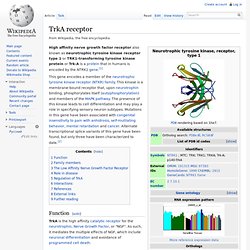
This kinase is a membrane-bound receptor that, upon neurotrophin binding, phosphorylates itself (autophosphorylation) and members of the MAPK pathway. The presence of this kinase leads to cell differentiation and may play a role in specifying sensory neuron subtypes. Mutations in this gene have been associated with congenital insensitivity to pain with anhidrosis, self-mutilating behavior, mental retardation and cancer. Alternate transcriptional splice variants of this gene have been found, but only three have been characterized to date.[2] Function[edit] TrkA is the high affinity catalytic receptor for the neurotrophin, Nerve Growth Factor, or "NGF". Family members[edit] Interactions[edit]